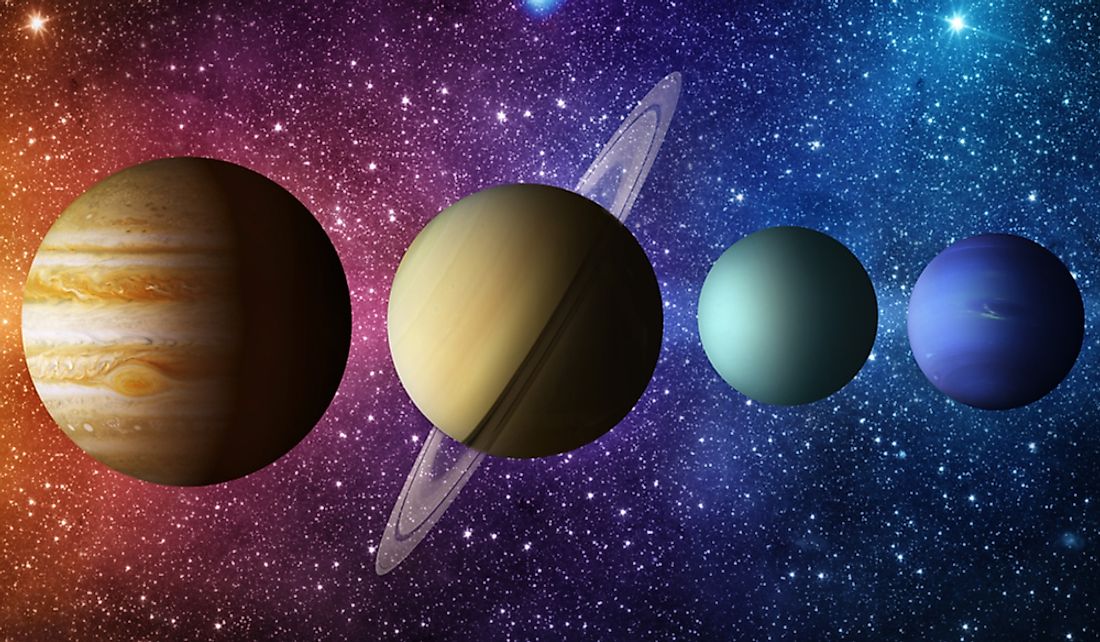What Are Giant Planets?

Giant planets are large planets that are composed primarily of materials with low-boiling-points, such as gases or ice, rather than rock or solid materials. However, large solid planets can also exist, such as Kepler-10c, which is an exoplanet that is ten times the mass of Earth. The Solar System contains four giant planets: Jupiter, Saturn, Neptune, and Uranus. Compared to Earth, these massive celestial bodies are located significantly further away from the Sun.
Types of Giant Planets
Gas Giants
The Solar System's two gas giant planets, Jupiter and Saturn, are composed primarily of hydrogen and helium. In addition to these gases, Jupiter and Saturn also contain heavier elements, which make up between 3% and 13% of their mass. The gas giants have an outer layer that is composed of molecular hydrogen, under which is a layer of liquid metallic hydrogen. The outermost part of the atmosphere contains numerous layers of clouds that are composed of ammonia and water.
Jupiter
Jupiter is the biggest planet in the Solar System and is located fifth from the Sun. In fact, Jupiter is 250% bigger than all other planets in the Solar System combined. The large gas giant is composed primarily of hydrogen, although 25% of its mass made up of helium. Unlike the other giant planets, Jupiter does not have a well-defined solid surface, and due to its rapid rotation, the planet has an oblate spheroid shape. Jupiter has 79 known moons, including the huge Galilean moons, which were discovered in 1610 by Italian astronomer Galileo Galilei. The four Galilean moons (Io, Europa, Ganymede, and Callisto) are some of the largest objects in the Solar System. In fact, Jupiter's biggest moon, Ganymede, is bigger than Mercury.
Saturn
Saturn is the second biggest planet in the Solar System and is located sixth from the Sun. The average radius of Saturn is nine times greater than Earth's radius. The inner part of Saturn’s core is composed of nickel-iron and rocks, such as oxygen and silicon compounds. The planet's core is enveloped by a metallic hydrogen layer, followed by layers of liquid helium and liquid hydrogen, and then an outer layer of gases. Saturn has a pale yellow tint due to the presence of ammonia crystals in its outer atmosphere. Saturn is known for its prominent ring system. Additionally, Saturn has a minimum of 62 moons, but only 53 have been named.
Ice Giants
The Solar System's two ice giants planets, Neptune and Uranus, have foggy atmospheric layers that contain small amounts of methane, which make the planets aquamarine in color. Ice giants have a hydrogen-rich atmosphere that stretches from the clouds down to 85% (Neptune) and 80% (Uranus) of their radius. Below the atmosphere, the ice giants are primarily composed of ammonia, methane, and water, as well as some rock.
Neptune
Neptune is the third most massive planet in the Solar System, as well as the fourth-largest in terms of diameter. It is seventeen times the mass of Earth and its outer atmosphere is the coldest part of the Solar System. Neptune is the furthest planet from the Sun and is not visible to the naked eye. The planet has fourteen known moons, the largest of which is Triton. Although mathematically predicted hundreds of years earlier, Neptune was first officially identified by German astronomer Johann Gottfried Galle on September 23, 1846.
Uranus
Uranus has the fourth-biggest planetary mass and the third-largest radius of any planet in the Solar System. The planet has the same composition as Neptune, but its atmosphere is similar to Saturn and Jupiter. The inner part of Uranus is composed of rocks and ice. Although not the furthest from the sun, it is the coldest planet in the Solar System. The planet was discovered by German-born British astronomer William Herschel on March 13, 1781, and has twenty-seven known natural satellites.











